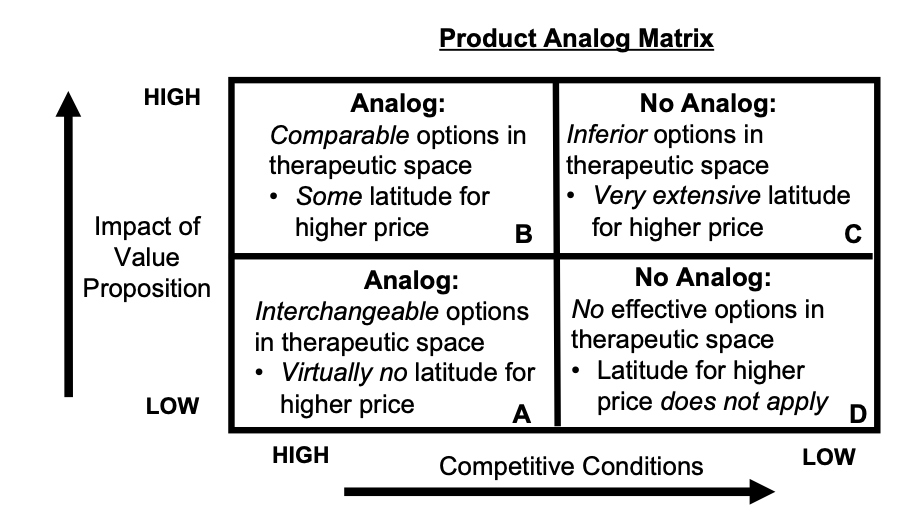Product Analogs Point to Pricing and Distinct Payer Market Scenarios
A business framework for pricing and broader brand strategy.

When conducting payer market research for drugs in development, a typical question asks for a product analog. Product analogs serve as price comparators to help develop a recommended price.
Based on my experience, there are four different intrinsic characteristics associated with product analogs. Each point to not only different pricing, but to different strategic profiles for products.
This article will put the spotlight on these four intrinsic characteristics. The suggestion here is two-fold. First, that the four types of product analogs align with four payer market scenarios. Second, that the four scenarios compose a business framework for pricing and brand strategy in the payer market.
In Scenario A, product analogs dictate a price ceiling with virtually no latitude for a higher price. This scenario is shaped by “clinically interchangeable” treatment options with generics and similar brands for the disease condition.
In Scenario B, the analog suggests a price ceiling with some latitude for a higher price. This scenario is shaped by “comparable” but not interchangeable treatment options for the disease condition.
There are also landscapes where good analogs do not exist. In Scenario C, latitude for a price ceiling is very extensive. Here, there are only “inferior” treatment options for the disease condition.
In Scenario D, latitude for higher pricing doesn’t apply because there is no benchmark for a price ceiling. In this last case, “no” effective treatment options for the disease condition exist.
Cutting across these four scenarios are two key business factors: competitive conditions and value proposition. Interaction of the two in each scenario produces a unique strategic profile for a future product in the payer market. These profiles are described in the product analog matrix shown below.

Pricing across the scenarios
Scenario A. Pricing is typically at parity or X % below the analog.
- Most commodified space.
- Less potential traction for clinical story and value proposition.
- High price/high rebate and subscription contracting very viable.
Scenario B. Pricing is capable of being X % above analog.
- Cost/quality trade-off is main battleground issue.
- Most challenging space for value propositions.
- If clinical differentiation is not established, pendulum swings to lower cost.
- Outcomes and indication-specific contracting potentially viable.
Scenario C. Pricing should reflect a “stretch price” (highest price that doesn’t invite management beyond what is naturally expected).
- Advances standard of care.
- “Clinical” as opposed to “statistical” significance is important.
- Cost should be subordinate to clinical benefit in value proposition.
- Payers will be interested in the number need to treat (NNT) to prevent or achieve the desired outcome.
- “Must add” to formulary is likely; preferred position unclear.
- Multiple indications building to “workhorse” agent is reasonable, long-term goal.
Scenario D. Extreme pricing is normative.
- Treatment based on transformational science.
- Home for orphan diseases plus gene and cell therapies.
- Framework is underdeveloped for correlating price and clinical benefit in value propositions.
- Population size is an especially important pricing variable.
To the degree future products fit one of the scenarios, this framework can be used to shape pricing and brand strategy. Projecting out, few new products are likely to fall under Scenario A; some will fall under Scenario B; industry R&D strives for most to fall under Scenario C; and steady escalation can be expected for Scenario D.
Ira Studin, PhD, President, Stellar Managed Care Consulting. He can be reached at istudin@stellarmc.com

Trump: 'Major Tariff' on Pharmaceuticals Coming Soon
Published: April 9th 2025 | Updated: April 9th 2025“We’re going to tariff our pharmaceuticals, and once we do that, they are going to come rushing back into our country," President Donald J. Trump said during a Tuesday night dinner in Washington.